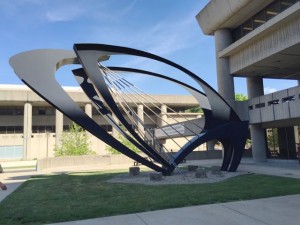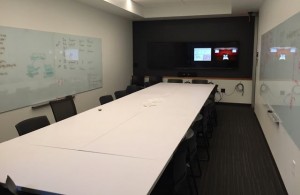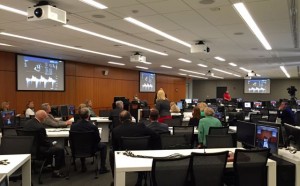Trustees follow on the heels of accreditation site-visit.
 The regularly scheduled June meeting of the UofL Board of Trustees will be held at various locations within the Health Sciences Campus this Thursday, June 4. It promises to be a long and busy session. [Agenda here.] In addition to its usual slate of business, Trustees will hear an update about the partnership with KentuckyOne Health from the CEO of Catholic Health Initiatives, Kevin Lofton. Interspersed with regular sessions will be walking tours to include the cardiovascular services at Jewish Hospital, the Neurorecovery Training Institute at Frazier Rehab, the Level 1 Trauma Center at University Hospital, the Center for Women and Infants within University Hospital, the UofL Healthcare Remote Physician Presence Robot Network, and the recently remodeled instructional facilities at the School of Medicine. I do not expect to see the same fireworks launched as at the May meeting, but who would have predicted then! Anything can happen.
The regularly scheduled June meeting of the UofL Board of Trustees will be held at various locations within the Health Sciences Campus this Thursday, June 4. It promises to be a long and busy session. [Agenda here.] In addition to its usual slate of business, Trustees will hear an update about the partnership with KentuckyOne Health from the CEO of Catholic Health Initiatives, Kevin Lofton. Interspersed with regular sessions will be walking tours to include the cardiovascular services at Jewish Hospital, the Neurorecovery Training Institute at Frazier Rehab, the Level 1 Trauma Center at University Hospital, the Center for Women and Infants within University Hospital, the UofL Healthcare Remote Physician Presence Robot Network, and the recently remodeled instructional facilities at the School of Medicine. I do not expect to see the same fireworks launched as at the May meeting, but who would have predicted then! Anything can happen.
LCME Accreditation Site visit.
The School of Medicine was visited in May by the Liaison Committee on Medical Education (LCME), the organization sponsored by the Association of American Medical Colleges and the American Medical Association that accredits American and Canadian schools of medicine and osteopathy– necessary for these professional schools to grant M.D. or D.O. degrees to their students. This important site visit is the first one following UofL’s School of Medicine being placed on probation last year. I expect that Medical School Dean Tony Ganzel will give an update on what the School had done to respond to the LCME’s concerns, and perhaps something about how the site visit went. I am unaware of the timetable for a final report and decision, but typically please things take several months. It would be nice to get things cleared up before the next application cycle and enrollment. Letters of acceptance have already gone out for next Fall’s entering class.
The renovations look great!
As chance would have it, I had a private tour in mid-May of the renovated teaching facilities in the current instructional building. I was impressed– indeed jealous that I never had anything so nice either as a student or a faculty member! The word gorgeous comes to mind. Clearly the School listened to the LCME and took its criticisms to heart. Yes the students got new lockers and bright and cheery homerooms with lots of power outlets and network plug-ins all around. More importantly, the organization of the instructional space has evolved beyond the large lecture hall format of spoon-fed passive learning. The space is broken up into units of medium-sized and smaller meeting rooms to accommodate the self-directed, small group collaborative, and interactive problem-based-learning that is emphasized in contemporary medical education.
There are realistic clinical exam rooms where students can interact with simulated patients and learn the skills of taking a medical history and performing a physical examination on a live (if not sick) person. Such interactions are monitored and allow feedback to the student. An assortment of mechanical- or computer-simulated clinical settings are also available. The gross anatomy laboratory looked pretty traditional, but it too has fascinating digital capabilities to help teach the three-dimensional and cross-sectional anatomy that is needed in the era of CAT-scans and MRIs.
The jewel of the renovation is a large meeting room decked out with a truly impressive array of digital audiovisual resources perfect for problem-based learning. From a command console, an instructor can lead the group through the discussion of a clinical problem; show elements of the history, physical examination, and laboratory studies; put up x-rays and scans, show microscope slides, and has the ability to access the vast resources of the Kornhauser Medical Library on the fly. The discussion is not one way, and no one should dare to fall asleep! Students can be polled collectively on their thinking with the results displayed for all to see. Students are able to evaluate the entire instructional process including their own performances. I suspect we only scratched the capabilities of the new facility and its supporting software during my short visit.
More than bricks and mortar.
The LCME was critical of how the School developed, coordinated, and evaluated its curriculum across the four years of study. From what I could determine, the Medical School has attempted to respond to these issues also. For example, a huge searchable matrix of what is taught, by whom, to whom, where, and when is available to all students and faculty. I saw some examples of how the ability to access the database (which contains lecture notes and other instructional materials) can be very helpful. It also occurred to me that maintaining and updating such a massive amount of information is a daunting and expensive task. I hope it is worth it. One of the potential downsides of any accreditation process is that useful standardization may morph into undesirable suppression of experimentation or innovation. No doubt UofL will do whatever it understands that the LCME wants it to do. More often than not, that would not be a bad path to follow– especially if a school wants to avoid probation or worse. However, my observations of some of the medical quality and performance ratings, and of other attempts by private and governmental organizations to set medical standards confirms my belief that accreditors do not always get it right, are slow to evolve, and that the unanticipated consequences of marching to their tunes are not always entirely benign.
An essentially new library.
I use the Kornhauser Medical Library from time to time and had already seen some of the changes of the past few years. Responding to students needs, the library is now open 24 hours per day with spaces carved out for individual and small group study. The range of digital resources is expanding– I can even access texts and journals from home! As is occurring in many other places, the room available for the old fashioned book or bound medical journal is diminishing.
Where it all hits the road.
Perhaps more important and to the point, I had the occasion a month ago to meet privately with a medical student who was finishing their initial year– the first class to benefit from the renovated instructional facilities. The report from the student of the year’s experience was very positive. It was apparent that improvements to the curriculum and attempts to make information clinically relevant were paying off in student satisfaction.
Looking good.
I suspect that the LCME site-visitors will be pleased with the improvements made to the instructional facilities available to the first- and second-year students since their last visit. It won’t hurt that UofL has currently made a new $75 million Instructional Building for the Health Sciences Center its first priority for an outright state appropriation in next years legislative session. No bonding request here! [I would be disappointed if that ranking should fall should the LCME lift its probation before the next legislative session! Other people will be watching too.]
I met an outstanding medical educator during my visit whom I would be thrilled to have as my teacher or colleague. The School will need to convince the LCME that there is a broad commitment to these new approaches to medical education from both the basic science and clinical faclties.
Is there a rest of the story?
I cannot speak to the adequacy of clinical teaching facilities which are especially critical for the final two years of medical school. Things may not be as rosy there. You can only go so far with actors, robots, rubber models, or computers. The school has markedly increased its class size, but if anything, its clinical teaching facilities or capacity may be the same or even less. Hospital-wars have diminished collaboration with Norton Healthcare and those matters– including availability of pediatric clinical teaching opportunities– are far from settled. Also in this regard, and given the recent loss of faculty in the Department of Ob/Gyn, it will be important for the Trustees to hear the scheduled update on women’s healthcare services at University Hospital and in University clinics. The LCME reviewers would have asked about these matters too.
What questions should the Trustees ask?
I you were a trustee, what questions would you like to see addressed at the meeting– Health Science Center-related or otherwise? Send them in for all of us to see.
What if anything should be audited?
One reader pointed out that given time and resource restraints, it is impossible for Kentucky’s Auditor of Accounts to examine carefully the University and all of its far-flung foundations at once. Nonetheless, the Universities consistent if not arrogant refusal to disclose information that every court of law or Attorney General’s opinion so far has deemed to be in the public domain deserves to be challenged. If you were to give advice to the Auditor’s Office, what should be looked at first. I made a few suggestions for starters. What are yours?
Peter Hasselbacher, MD
President, KHPI
Emeritus Professor of Medicine, UofL
June 1, 2015
[Photos added June 4]

